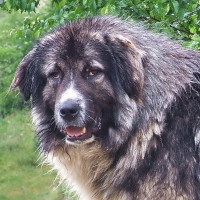Considered extinct now, Dinara sheepdog numbers began to decline after the Second World War, but they still existed in the western Krajina region of former Yugoslavia before the wars of the 1990s. It is thought that Serbian refugees took some of these large dogs with them to the east. It may therefore be possible for the breed to make a comeback. An old mountain Molosser, the so-called Krajinac (Kra-Yee-Natz) or Krajisnik (Kra-Yeesh-Nick) is a dog of imposing size, great intelligence and a very lively temperament. Not a herding breed, the Dinarac was used primarily as a protector of livestock and property. Considered the favorite breed of the old kings of Krajina, it was highly prized by the region's Serbian population for centuries. The breed was probably developed by crossing old Ragusa guard dogs and Bosnian Tornjaks with Sarplaninacs, Sylvans and the Herz Mastiff, but some also believe it to be a direct descendant of the ancient Naissus Molossus.
Described as a one-man dog, the Dinarian sheepdog shows little tolerance for strangers and other dogs. Devoted to its master, it is a good companion for people who keep to themselves, but is not suited to city life. Today, this breed is, like many others, lumped together under the name Tornjak in Croatia, which is inaccurate, given that the Dinarac is comparatively a shorter-haired dog, a true mastiff in head, taller and bulkier than any Croatian Tornjak its tail is traditionally docked and its ears sometimes cropped, broadly resembling certain types of Central Asian sheepdog.
While there are examples of brindle, fawn and black-bronze, the Dinarian sheepdog's preferred color is a uniform wolf-gray, although white markings on chest and legs are fairly common. The ideal height is said to be around 81 centimeters, but this is the original variety of the past, with the majority of surviving pre-war specimens in Yugoslavia measuring around 69 centimeters at the withers. |







 English (United Kingdom)
English (United Kingdom)